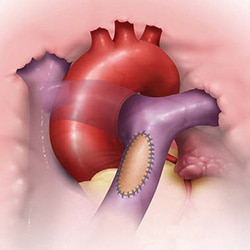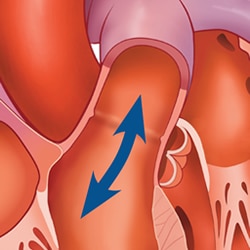WHAT IS CONGENITAL HEART DISEASE?
Congenital heart disease (CHD) is the most common birth defect, affecting almost 1% of babies born each year.1 Most heart defects are present at birth, caused by the heart not developing the way it should during pregnancy. Some of these defects affect the heart valves.
ABOUT THE PULMONARY VALVE
The pulmonary valve directs blood flow from the right lower chamber (right ventricle) into the main pulmonary artery, which splits into two arteries so that the blood from the heart can get to both lungs. Pulmonary valve disease is a condition in which the pulmonary valve doesn't function properly.
Pulmonary Valve Conditions
The following congenital heart disease (CHD) conditions most commonly affect the pulmonary valve:
- Pulmonary Atresia: In this condition, the pulmonary valve is abnormal and does not open like it should. This means that blood cannot go to the lungs to pick up oxygen.
- Tetralogy of Fallot: This condition refers to four heart defects that usually occur together: a hole between the right and left pumping chambers of the heart (ventricles), a narrowed path between the right ventricle and the pulmonary artery, an artery (aorta) that is connected to the heart closer to the right side of the heart than normal, and a thicker than normal pumping chamber (ventricle) on the right side of the heart.
- Double Outlet Right Ventricle: In this condition, both the main arteries — one that carries blood to the lungs (main pulmonary artery) and one that carries blood to the rest of the body (aorta) — are connected to the right lower chamber of the heart (ventricle). Usually, the aorta is connected to the left lower chamber of the heart.
Treatment Option for native or surgically repaired right ventricular outflow tract (RVOT)
If you have a congenital heart condition that affected your pulmonary valve, this may have required a procedure early in life to help blood flow to the lungs, leaving you with a native or surgically-repaired right ventricular outflow tract.
After having one of these procedures, you may or may not have a working pulmonary valve, which could cause regurgitation or blood leaking backward into the right lower chamber of the heart (ventricle). This causes the heart to pump harder than it should to bring blood back to the lungs. If the leakiness of the valve is severe, replacement of the pulmonary valve may be recommended.
Patients with pulmonary insufficiency who have severe pulmonary regurgitation with a native or surgically repaired right ventricular outflow tract (RVOT) may be a candidate for the Harmony™ transcatheter pulmonary valve.
NATIVE OR SURGICALLY REPAIRED RIGHT VENTRICULAR OUTFLOW TRACT (RVOT)

LEAKING (REGURGITATION)

Treatment option for pulmonary conduit or surgical valve replacement
Children and adults with pulmonary valve disease may have narrowed pulmonary valves and may need surgery for placement of a right ventricular outflow tract (RVOT) pulmonary conduit or surgical valve. A pulmonary conduit is a tube that connects the heart to the lungs.
These CHD patients may need a device like the Melody™ transcatheter pulmonary valve when their surgical valve or conduit needs replacement.
PULMONARY VALVE CONDUIT OR SURGICAL VALVE FAILURE
Over time, mineral deposits (calcification) may build up on the conduit or surgical valve, and it may become narrowed and/or leaky. This may happen as you outgrow the conduit or surgical valve, as they wear out from the pressures of pumping blood, or from calcium buildup.
NARROWED CONDUIT OR VALVE (STENOSIS)

The conduit or valve opening is narrowed, which limits blood flow from the heart to the lungs and forces the heart to work harder than normal. Stenosis may be caused by a build-up of minerals on the outflow tract walls (calcification). Stenosis can make the heart muscle thick and prevent it from working well. It can also limit the amount of blood pumped to the lungs.
LEAKY CONDUIT OR VALVE (REGURGITATION)

The conduit or surgical valve does not have a properly working valve which causes blood to leak backward into the right lower chamber of the heart (ventricle). This causes the heart to pump harder than it should to bring blood to the lungs and the rest of your body.
SYMPTOMS THAT MAY MEAN YOU NEED A NEW VALVE
- Becoming tired or short of breath with activity
- Feeling tired, dizzy or too weak to do your normal activities
- Irregular heartbeats or the feeling that your heart is racing or pounding in your chest
- Fainting or near fainting
Symptoms can range from mild to severe. If you are experiencing any of these symptoms, talk with your heart doctor. Regular check-ups and testing can help determine how your pulmonary valve conduit is working.
Hoffman JL, Kaplan S. The incidence of congenital heart disease. J Am Coll Cardiol. June 19, 2002;39(12):1890-1900.
Information on this site should not be used as a substitute for talking with your doctor. Always talk with your doctor about diagnosis and treatment information.